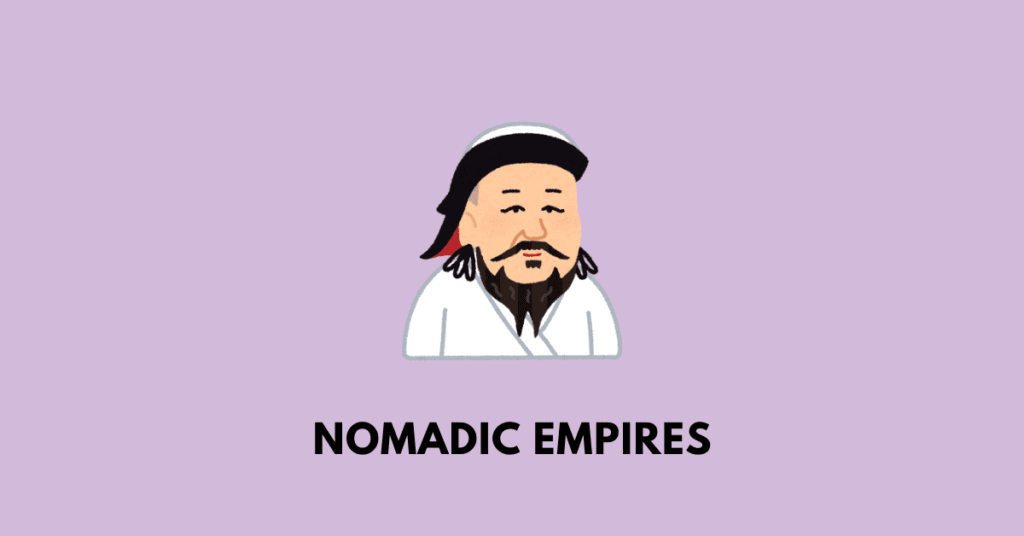Get summaries, questions, answers, solutions, notes, extras, PDF and guide of Class 11 (first year) History textbook, chapter 3 Nomadic Empires which is part of the syllabus of students studying under AHSEC/ASSEB (Assam Board). These solutions, however, should only be treated as references and can be modified/changed.
If you notice any errors in the notes, please mention them in the comments
Summary
The chapter discusses the rise and expansion of the Mongol Empire under Genghis Khan. It begins by explaining how the Mongols, originally a group of nomadic tribes, transformed into a powerful empire. Nomads traditionally moved from place to place with their animals, while an empire suggests control over fixed lands. The Mongols managed to do both, adapting their traditions to rule a vast territory.
Genghis Khan, born as Temujin, united the Mongol tribes through alliances and battles. He created a strong army, using discipline and strategy to defeat enemies. His military success was based on speed, organization, and the ability to adjust tactics. He conquered China, Central Asia, and parts of Europe, causing fear among settled societies. His grandson, Mongke, continued his vision, claiming that the Mongols ruled by the will of heaven. The Mongols’ swift expansion led many to believe that they were a force sent as divine punishment.
One of Genghis Khan’s notable victories was the capture of Bukhara in 1220. After taking the city, he told the people that their sins had brought destruction upon them. His forces burned, looted, and killed many inhabitants. This was common in Mongol conquests, as they destroyed cities that resisted them. The Mongols’ military campaigns led to massive destruction and loss of life.
Despite their reputation for violence, the Mongols also created an organized empire. They set up a communication system with relay stations that helped rulers stay informed. They controlled trade routes, allowing merchants to travel safely. They respected different religions and often included scholars and administrators from conquered lands in their government.
After Genghis Khan’s death in 1227, his empire was divided among his sons. They continued to expand, reaching Russia, the Middle East, and China. However, by the late 1200s, internal struggles weakened Mongol unity. Different Mongol rulers focused on their own territories. In China, Genghis Khan’s grandson, Qubilai Khan, ruled as emperor and protected farmers. In Iran, another Mongol ruler, Ghazan Khan, advised his commanders not to harm peasants, as agriculture was important for stability.
Over time, the Mongols adapted to the ways of settled societies, and their empire eventually broke into separate states. Though feared by many, their rule connected different parts of the world, allowing trade and cultural exchanges. Today, Genghis Khan is remembered as both a fearsome conqueror and a great leader who united the Mongol people.

Video tutorial
Textbook solutions
Answer in Brief
1. Why was trade so significant to the Mongols?
Answer: Trade was significant to the Mongols because commerce and travel along the Silk Route reached its peak under their rule. Unlike before, the trade routes did not terminate in China but continued north into Mongolia and to Karakorum, the heart of the Mongol empire. Communication and ease of travel were vital to maintaining the coherence of the Mongol regime, and travelers were given a pass (paiza in Persian; gerege in Mongolian) for safe conduct. Traders paid the baj tax for the same purpose, all acknowledging the authority of the Mongol Khan.
2. Why did Genghis Khan feel the need to fragment the Mongol tribes into new social and military groupings?
Answer: Genghis Khan felt the need to fragment the Mongol tribes into new social and military groupings to systematically erase old tribal identities. His army was organised according to the old steppe system of decimal units (10s, 100s, 1,000s, and 10,000s), but unlike the past, he divided tribal groupings and distributed their members into new military units. This prevented clan-based loyalties and ensured direct allegiance to him. Anyone who tried to move from their allotted group without permission faced harsh punishment. The largest unit of soldiers, the tuman (10,000 soldiers), included people from different tribes and clans, integrating them into a new social order under his leadership.
3. How do later Mongol reflections on the yasa bring out the uneasy relationship they had with the memory of Genghis Khan.
Answer: Later Mongol reflections on the yasa show their uneasy relationship with Genghis Khan’s memory by reshaping his legacy. Initially, yasaq referred to administrative laws, but by the mid-thirteenth century, it became a sacred legal code to unify the Mongols as they ruled over diverse urban societies. To maintain their identity, they framed Genghis Khan as a lawgiver like Moses or Solomon. Later Il-Khanid chronicles exaggerated his brutality, expressing relief that those violent times had passed. This adaptation helped make his successors more acceptable to their sedentary subjects while preserving his authority.
4. ‘If history relies upon written records produced by city-based literati, nomadic societies will always receive a hostile representation.’ Would you agree with this statement? Does it explain the reason why Persian chronicles produced such inflated figures of casualties resulting from Mongol campaigns?
Answer: The steppe dwellers themselves usually produced no literature, so our knowledge of nomadic societies comes mainly from chronicles, travelogues, and documents produced by city-based litterateurs. These authors often produced extremely ignorant and biased reports of nomadic life.
Persian chronicles produced in Il-Khanid Iran during the late thirteenth century detailed the gory killings of Genghis Khan and greatly exaggerated the numbers killed. For example, in contrast to an eyewitness report that 400 soldiers defended the citadel of Bukhara, an Il-Khanid chronicle reported that 30,000 soldiers were killed in the attack on the citadel. Although Il-Khanid reports still eulogized Genghis Khan, they also carried a statement of relief that times had changed and the great killings of the past were over. The Genghis Khanid legacy was important, but for his descendants to appear as convincing heroes to a sedentary audience, they could no longer appear in quite the same way as their ancestor.
Answer in a Short Essay
5. Keeping the nomadic element of the Mongol and Bedouin societies in mind, how, in your opinion, did their respective historical experiences differ? What explanations would you suggest account for these differences?
Answer: The historical experiences of the Mongol and Bedouin societies differed significantly due to their interactions with surrounding civilizations and their approaches to political and military organization. The Mongols, under Genghis Khan, established a transcontinental empire that spanned Eurasia, creating an organized and disciplined military force that conquered agrarian and urban societies. They adapted their steppe traditions, integrating new administrative structures and recruiting officials from the conquered regions to govern effectively. The Mongols’ military innovations and ability to incorporate diverse cultures into their administration contributed to their vast empire.
On the other hand, the Bedouins, originating from the Arabian Peninsula, played a crucial role in the formation of Islamic polities. Their nomadic traditions influenced the early Islamic state formations in central Islamic lands. Unlike the Mongols, who established a large, centralized empire, the Bedouins’ political influence was more fragmented, with their traditions shaping tribal and kin-based governance structures. The Bedouins engaged in trade and warfare but did not create an empire on the scale of the Mongols.
The differences in their historical experiences can be attributed to their geographical locations, economic structures, and the nature of their interactions with settled societies. The Mongols operated in the vast steppes of Central Asia, where their military campaigns brought them into contact with powerful states like China, Persia, and Eastern Europe. Their ability to mobilize large cavalry forces and utilize siege warfare enabled them to dominate agrarian civilizations. In contrast, the Bedouins lived in the harsh desert environment of Arabia, where their economy was based on herding, trade, and small-scale raids. Their interactions with sedentary societies were more limited in scope, and their influence was often seen in the cultural and religious domains rather than military conquest.
6. How does the following account enlarge upon the character of the Pax Mongolica created by the Mongols by the middle of the thirteenth century?
The Franciscan monk, William of Rubruck, was sent by Louis IX of France on an embassy to the great Khan Mongke’s court. He reached Karakorum, the capital of Mongke, in 1254 and came upon a woman from Lorraine (in France) called Paquette, who had been brought from Hungary and was in the service of one of the prince’s wives who was a Nestorian Christian. At the court he came across a Parisian goldsmith named Guillaume Boucher, ‘whose brother dwelt on the Grand Pont in Paris’. This man was first employed by the Queen Sorghaqtani and then by Mongke’s younger brother. Rubruck found that at the great court festivals the Nestorian priests were admitted first, with their regalia, to bless the Grand Khan’s cup, and were followed by the Muslim clergy and Buddhist and Taoist monks…
Answer: The account provided enlarges upon the character of the Pax Mongolica by illustrating the diverse and interconnected nature of the Mongol Empire. The presence of individuals from different parts of Europe, such as Paquette from Lorraine and the Parisian goldsmith Guillaume Boucher, highlights the far-reaching influence of the Mongol realm. These individuals, brought from distant regions, were integrated into Mongol society and served at the court of Mongke Khan.
Additionally, the religious inclusivity of the Mongol court is evident in the sequence of blessings at the great court festivals, where Nestorian priests were admitted first to bless the Grand Khan’s cup, followed by Muslim clergy, and then Buddhist and Taoist monks. This reflects the Mongols’ policy of religious tolerance and their ability to accommodate multiple faiths within their empire.
The account emphasizes how the Mongol Empire facilitated movement, trade, and cultural exchange across vast distances, demonstrating a level of cosmopolitanism that was a hallmark of the Pax Mongolica. It illustrates the stability and interconnectedness that the Mongols fostered, allowing for artisans, religious figures, and diverse individuals to thrive within their expansive domain.
Extras
Additional questions and answers
Coming soon
Additional MCQs
Coming soon

Get notes of other boards, classes, and subjects
